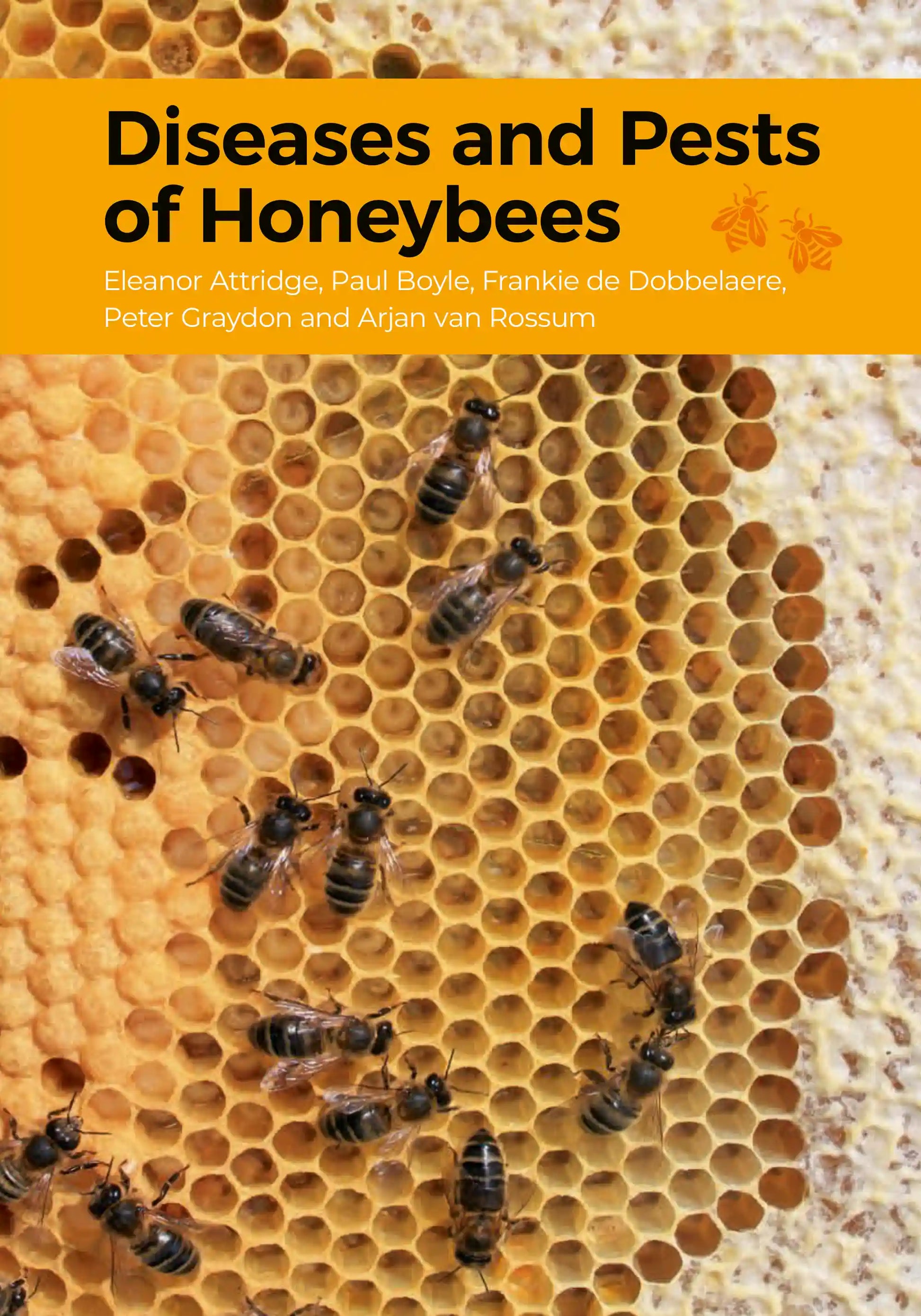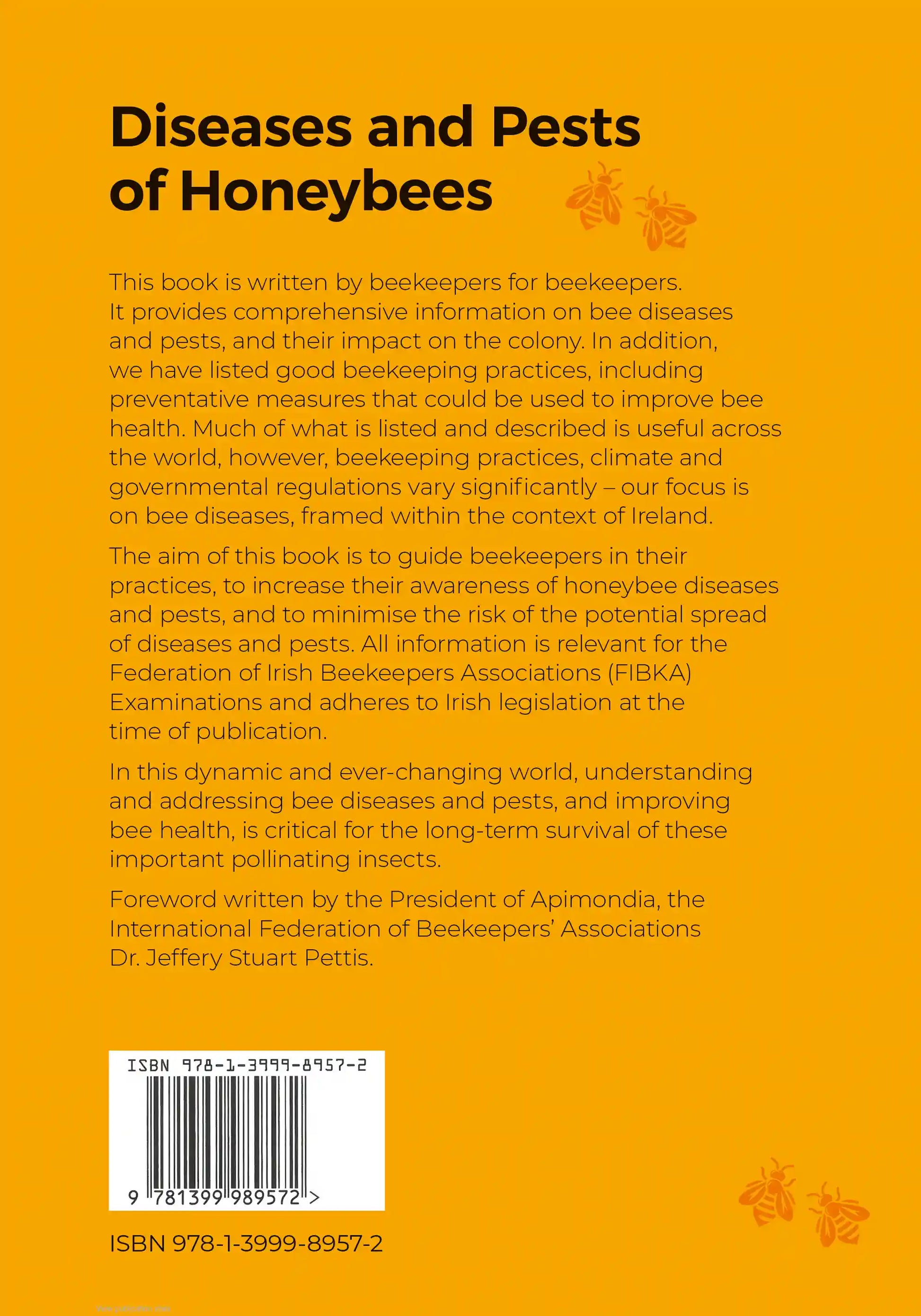Diseases and Pests of Honeybees by Eleanor Attridge, Paul Boyle, Frankie de Dobbelaere, Peter Graydon & Arjan van Rossum


Diseases and Pests of Honeybees
This book is written by beekeepers for beekeepers. It provides comprehensive information on bee diseases and pests, and their impact on the colony. In addition, we have listed good beekeeping practices, including preventative measures that could be used to improve bee health. Much of what is listed and described is useful across the world, however, beekeeping practices, climate and governmental regulations vary significantly - our focus is on bee diseases, framed within the context of Ireland.
The aim of this book is to guide beekeepers in their practices, to increase their awareness of honeybee diseases and pests, and to minimise the risk of the potential spread of diseases and pests. All infromation is relevant for the Federation of Irish Beekeepers Associations (FIBKA) Examinations and adheres to Irish legislation at the time of publication.
In this dynamic and ever-changing world, understanding and addressing bee diseases and pests, and improving bee health, is critical for the long-term survival of these important pollinating insects.
Foreword written by the President of Apimondia, the International Federation of Beekeepers Associations Dr. Jeffery Stuart Pettis.
VIEW Contents
- Foreword
- Acknowledgements
- Instructions to Carry Out a Full Disease Inspection
- Apiary Hygiene
- Bacterial Notifiable Diseases
- American Foulbrood (AFB)
- European Foulbrood (EFB)
- Honeybee Mites
- Varroa
- Acarine/Tracheal Mite Infestation
- Tropilaelaps Mite Infestation
- Bee Louse
- Braula caeca Infestation
- Single Cell Organism Diseases
- Nosema
- Amoebiasis of the Malpighian Tubules
- Lotmaria passim and Crithidia mellificae
- Fungal Diseases
- Chalkbrood
- Stone Brood
- Viral Diseases
- Sacbrood
- Deformed Wing Virus (DWV)
- Black Queen Cell Virus (BQCV)
- Chronic Bee Paralysis (CBPV)
- Acute Bee Paralysis Virus (ABPV)
- Kashmir Bee Virus (KBV)
- Israeli Acute Paralysis Virus (IAPV)
- Cloudy Wing Virus (CWV)
- Pests
- Wax Moth Infestation
- Small Hive Beetle - Aethina tumida Infestation
- Asian Hornet - Vespa velutina
- Integrated Pest Management (IPM)
- Queen/Brood Issues
- Drone Laying Queen
- Laying Workers
- Diploid Drones
- Chilled Brood
- Overheated Brood
- Other
- Dysentery
- References
- Index
- Author Biographies
VIEW Book Review
Reviewed by Paul Honigmann (Author of The Observant Beekeeper: Treatment Free, Low Intervention)
Clear explanations, accurate information, practical advice and fantastic photos.
Having written and researched a bit about honeybee diseases, I picked up this book at a honey show and was very impressed - enough so to write my first book review for years. I have no connection to any of the authors; I'm a beekeeper in England. Most beekeepers who talk about bee disease have only seen 3-6 diseases, and ascribe everything to whatever their own main problem is, unquestioningly repeating errors cut and pasted from the internet. This book is by a group of 5 authors with experience ranging from large scale beekeeping, veterinarian, Apimondian honey judge, county bee health officer and more. The breadth of knowledge shines through. Until I read the biographies, I assumed at least one must be an academic studying bees because everything is so clearly described and consistently detailed. (I do wonder how 5 beekeepers could agree on anything, but the writing has a consistent style.)
The level of detail is interesting. They clarify things marvellously without swamping your brain with Too Many Words. I was really impressed by the descriptions of how to recognise things - like examining a squashed bee's gut colour, that's new to me; that they describe how some symptoms change with season or infection level; they don't ascribe Isle of Wight disease to a single cause; they point out that certain symptoms are ambiguous. And I'd like to emphasise that even though I know more about disease than at least 95% of beekeepers, my copy is now stuffed full of post-its marking points of use and interest. Have I mentioned the photos and diagrams? Stunning. Hugely jealous of their camerawork.
It's usual for reviewers to discuss a book's weaknesses but there aren't any. And that's despite me following a completely different style of frameless low-management beekeeping. This book is an amazing reference book for anyone using standard modular hive management techniques, it is just the right mix of practical advice and helpful insight & explanation. I feel potential buyers also need to know what the book covers, so here's a brief contents list:
[General notes on apiary and disease management]; AFB, EFB, mites and Varroa, Acarine / Tracheal mites, Tropilaelaps, Braula, Nosema, Amoebiasis, Lotmaria passim and Crithidia mellificae, Chalkbrood, Stonebrood, Sacbrood, DWV, BQCV, paralysis viruses - CBPV, ABPV, KBV, IAPV, CWV; wax moths (both); SHB, Asian Hornet; Brood disorders - drone laying queen / workers, diploid drones, chilled/overheated brood; Dysentery.
Unavailable